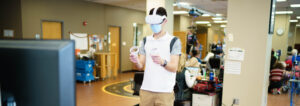May is Better Speech and Hearing Month

Back to physical health resource hub
This month is dedicated to improving knowledge and awareness regarding Speech and Language intervention and treatment practices. One area of speech therapy services includes swallowing assessments and swallowing treatment. Swallow assessments can be completed with non-instrumentals (bedside) as well as instrumental examinations (FEES or VFSS/MBSS).
The use of instrumental assessments like Fiberoptic Endoscopic Evaluation of Swallow (FEES), Modified Barium Swallow Study (MBSS)/Video Fluoroscopic Swallow Study (VFSS) help speech therapists to better understand our patient’s impairments and their treatment needs to provide the best possible outcomes for each individual with swallowing difficulties (dysphagia).
What is FEES?
Fiberoptic Endoscopic Evaluation of Swallowing (FEES) is an instrumental procedure to assess the safety and efficiency of, primarily, the pharyngeal stage of swallowing. FEES is used without concerns of radiation exposure and can be used within therapeutic contexts and for diagnostic therapy to assess current progress and effectiveness of therapy.
A FEES can be conducted in an outpatient facility, bedside in a hospital, nursing home, or home setting by a speech-language pathologist (SLP) or a medical doctor. The patient is given various consistencies of food and liquid mixed with dye food coloring, which allows the bolus to be seen on the fiberoptic camera view before and after the swallow in the pharyngeal area of the throat. The FEES is beneficial in identifying whether aspiration has occurred. The FEES is also used to determine the presence, timing and amount of residue and penetration/aspiration.
FEES studies have gained undeniable credentials as a reliable, valid and safe procedure for assessing oropharyngeal swallowing functions. This is particularly significant for patients who cannot be transported, such as those on ventilators, in isolation, in intensive care in hospitals, and for residents in nursing care facilities.
Limitations of FEES
- Inability to visualize the oral or the esophageal phase of swallowing.
- Limited ability to visualize the pharyngeal phase. However, a clinician may be able to visualize the initiation of pharyngeal structural movements through:
- The pharyngeal squeeze,
- Superior movement, and/or
- Epiglottis inversion.
- “White-out”—passage of the bolus and movement of the pharyngeal structures cannot be observed during the swallow because of reflected light from pharyngeal and laryngeal tissues into the endoscope.
- Inability, by some patients, to tolerate the procedure due to discomfort and/or medical conditions.
What is a VFSS or MB SS?
The videofluoroscopic swallowing study (VFSS), also known as the modified barium swallow study (MBSS), is a radiographic procedure that provides a direct, dynamic view of oral, pharyngeal, and upper esophageal function. A VFSS is typically conducted in a hospital by a speech-language pathologist (SLP) and radiologist. The patient is given various consistencies of food and liquid mixed with barium (or other contrast material), which allows the bolus to be visualized in real time on an X-ray during the swallow.
The VFSS is beneficial in identifying whether aspiration has occurred. The VFSS is also used to determine the presence, timing and amount of aspiration as well to assess the anatomy and pathophysiology of oropharyngeal swallow function. The VFSS can also be used to gather information on the influence of compensatory strategies. This information is clinically useful in the development of a treatment plan.
Limitations of the VFSS/MBSS:
- Time constraints due to radiation exposure.
- A limited sample of swallow function that may not be an accurate representation of typical mealtime function.
- Challenges in visualizing the swallow due to poor contrast.
- Challenges in representing food typically eaten by a patient.
- Limited evaluation of the effect of fatigue on swallowing.
- Refusal of the bolus, as barium is an unnatural food source and is not tolerated by some patients (Logemann, 1998).
- Positioning may not be optimal.
- Fluoroscopy time parameters.
- Severe oral aversive behaviors that limit oral intake during an examination.
Function of the swallowing mechanism is not an area people usually associate with speech therapy, however dysphagia is something that a speech therapists is well trained in and they play an important role in helping to rehabilitate or compensate for dysphagia issues. It is important to know what is considered normal when it comes to our swallowing functions, so that we can identify when something is amiss and get help to assess with the use of FEES or VFSS/MBSS instrumental assessments available through various Brooks Rehabilitation settings.
If you or someone you know has swallowing issues and wants to know more about how speech therapy can help you, reach out to your local Brooks Rehabilitation to set up an evaluation to create a customized treatment plan to address your specific needs.






